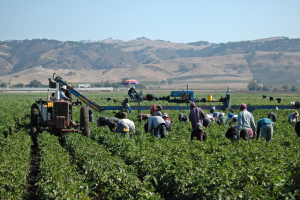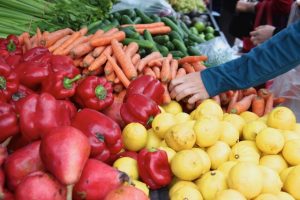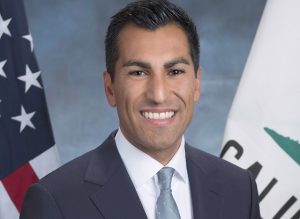The Hunger Challenge Brings Fresh Insights and Renewed Feelings
September 25, 2008 Michael R. DimockIt’s called The Hunger Challenge and a colleague in the good food movement from the San Francisco Department of Public Health, Paula Jones, asked me to join her in accepting it. I said “yes” when she explained it was a way to comprehend living with only $4 per day for food. That is the amount received by a recipient of SNAP (Supplemental Nutrition Assistance Program), formerly known as food stamps. I have been doing it for just three days.
I have been hungry for most of the time. On Sunday, I began my day with friends and ate up almost all my $4 with a delicious breakfast of three small eggs, scrambled, two slices of melon and one of toast, plus two cups of thick black coffee. Consequently, I did not eat a full meal the rest of the day. I only had some bread and sliced tomato.
It was a $4 breakfast because the eggs and melons were from the Healdsburg, CA Farmers Market, which is among the priciest markets I know. A dozen eggs can cost $9.00 or 75¢ per egg. Yes, they are from happy, healthy chickens, but that is expensive. I am not complaining. The Healdsburg market should be expensive. The majority of food there is organic and grown on small family farms that achieve exquisite quality and treat animals with dignity. The land from which the food is grown is among the most expensive in the State because of its value for winegrapes. To justify farming produce, you must receive a fantastic price for your offering. Another way to see it is that maintaining diversity of agriculture in Sonoma County costs its citizens money.
The really good news about the Healdsburg’s farmers market is the Farm to Pantry project. Each week you’ll find a table where project organizers recruit community gleaners and the project’s founder, Melita Love, gathers left over produce from the vendors who wish to donate to the local food pantries. Between gleaners and market vendors, Love and her colleagues provide hundreds of pounds of fresh and healthy food to families in need each month. But I digress.
My point here is that at my first breakfast on Sunday it was clear that I, as a single, well-employed person, do not face the same realities as those living on food stamps. We eat different food. I can shop at a farmers market without thinking about the prices. A SNAP recipient cannot. I am more food free.
Eating on $4 per day requires careful thought, particularly if you want to eat healthfully. I learned this Sunday evening. Paula and I went to three stores in San Francisco in order to buy food for the few days we would participate in The Hunger Challenge. Many SNAP recipients would not have the luxury or ability to travel to three markets because of transportation issues, childcare needs, or time constraints. But we needed three stores to find and afford the food we wanted to eat.
Here is what we bought: pasta (93¢), white basmati rice ($2.99), 9 slightly bruised organic gala apples ($2.77) in a bag, ¾ lb. of Monterey Jack cheese ($2.51), 12 eggs ($1.90), head of broccoli ($1.57), 3 carrots (68¢), 2 onions (89¢), 2 cans of back beans ($1.78,) 1 lb. can of ground coffee ($2.98), and 1 bulb of garlic (50¢). Due to the prices, we could not buy the whole wheat pasta, brown rice, or organic beans we really wanted. The total amount came to $19.46, which was $3.46 over our budget, but we factored in that we would have rice, pasta and coffee left over for other days beyond the Challenge.
Leaving the store, I felt fully provisioned for Monday through Wednesday evening when I would need to end my Challenge due to a business trip. Well, almost fully provisioned. Due to my schedule, I actually had to prepare the meal of black beans and rice that night. It was 10 pm by the time I got back to my apartment from shopping. I made rice while I sautéed an onion and garlic for the black beans and rice. Remember, this was Sunday night after only the aforementioned breakfast and tomato slices on bread in the afternoon. I was very hungry and it took all my will power not to eat the onions as I cooked them. I was able to resist. I got to bed about 11:30 pm.
I awoke Monday morning famished and cooked two eggs to which I added some white rice and some Tabasco sauce. I also enjoyed one cup of thick black coffee. I initially feared I would not have a drop of coffee during the Challenge. I believed this because I begin each day with a walk to work during which I purchase a $1.50 cup of coffee from a sandwich shop. But my budget only allowed $1.00 for all of breakfast. But thanks to Foods Co, the Kroger big box format store, I found Bustelo Coffee. It is cheap, an espresso grind, and it is not bad. So I got my coffee, but just one cup, and then off to work.
By 11 am Monday, I was hungry again. I waited until noon and ate my two small apples and 2 oz. of cheese. By 4 pm I was again famished. I then realized I was facing a very tough challenge indeed at 6 pm when I would attend a dinner party. I informed the host that I could not participate in the menu provided. The host, Larry Bain, a great cook and co-founder of Let’s be Frank Hot Dogs, graciously accepted my conditions. On the way to the party, I exchanged some black beans and rice for some pasta, which Paula had prepared. We wanted to diversify our diets a bit.
I brought the dish of pasta with broccoli and carrots to Larry’s house. I sat with a smile while we all joked about my inability to join in as they ate olives, radishes, chicken wings and drank lemon drops, prepared from $30 vodka, $20 agave syrup, and hand squeezed lemons by one of my dinner companions. During the second course of homemade grav loks with romaine leaves and the main course of fresh corn, cherry tomatoes and shrimp, accompanied by an Italian white wine, I had the experience of a “have not” in a “have lots” crowd.
I was aware of my hunger and desire to join in and how easily that could morph into resentment if I actually were unable to partake at time in the future. Surprisingly to me, I resisted and lived within my budget. I made it home still a full participant in The Hunger Challenge. I must also say that the water I drank and the pasta dish filled me up. My hunger was fully sated for the first time that day.
I awoke this morning thinking that I have become really quite spoiled and am truly privileged. As I soft boiled my eggs and made a cup of coffee, I realized that when I was a university student, I lived on a budget and shopped with cost in mind. I was disciplined about preparing menus for the week. I actually enjoyed the challenge associated with making my life work on my limited budget. When I was 21 and worked in a village in Nepal, we ate only rice and roots for the last month I was there. I was hungry every day, lost 20 lbs, and hated those roots, but I did it.
Today, I do not plan meals a week ahead, ever. I often spend $50-$100 on a dinner when in San Francisco. I seek only the highest quality food when shopping: organic, small farms, local, clean, and fresh. I rarely consider food prices or get really hungry. I need to lose 20 lbs. Food is a real source of joy for me. I love to shop, prepare sumptuous meals, feed those I love, and I love to eat. These are luxuries and part of my identity. Clearly, $28 per week for food would alter my identity. I would not be who I am now.
Beyond these personal insights, I have others thoughts to share.
First, the good food movement needs to intensify its commitment to regional food systems that increase the amount of urban agriculture. A majority of SNAP recipients live in the inner city where healthy fresh produce is often hard to get. To the extent that we can create more urban farms and gardens, we will increase the supply of healthy food where it is most needed and we may get it to people for free or very low cost if that food is grown in their neighborhoods.
Second, the causes of Hunger receive too little attention. SNAP and food banks are a band aids. They are good in that one can eat enough to live because of them. However, to eat healthfully is a real challenge unless you have time to supplement SNAP with good and free pantry foods, shop thoughtfully, and cook from scratch. In the end we need approaches that will overcome the causes of hunger.
Third, we need food sovereignty in every region of the nation and the world. Food sovereignty is power and control over ones food supply. Food sovereignty will come from good policy, economic health and activity, regional food production and markets, and the survival drive and entrepreneurship of people provided opportunities to produce food close to home. Food sovereignty will contribute to poverty alleviation by creating jobs that pay livable wages and community food production activity for those unable to find or hold good jobs.
Fourth, ending poverty is not simply about unfettered economic activity. Poverty is multi dimensional and has many causes. Overcoming it requires human empowerment through family and community health, education of youth, nurturance of creativity and innovation, opportunity, and justice.
Some argue that poverty is a problem of personal responsibility, but life is complex and social problems are rarely caused by one thing. We need to find the fine balance between personal and collective responsibility. This balance is very hard to find and few agree on where the line is best drawn.
Fifth, if it is good policy to collectively defend against threats from abroad by taxing ourselves to build armies; it is also good policy to tax ourselves to build programs that will defend against threats at home. Threats include ignorance, prejudice, hunger, and injustice. History proves that these lead to social instability, crime, violence, and destruction. As I look out at the nation, I perceive the seeds of social unrest born of industrialism that destroys the ecosystem and culture; racism that destroys self-esteem, opportunity, and vision; fundamentalism that destroys diversity and compassion; and egoism that destroys a sense of common purpose and journey.
Sixth, our nation needs to find its deep pools of empathy and compassion. It appears to me that we are not yet able embrace those who suffer from deep racial, religious, emotional, and psychological wounds and cannot fully fend for themselves. So many of us still judge or resent those in need. So many still feel entitled to keep all we have earned because we do not see that our own opportunity and success is an outgrowth of the nation to a significant degree. Many do not see the full significance of the fact that the nation is an inheritance, created and nurtured by all those who have gone before us. We must all give back to it more than the amount we would probably like to give. I am not just speaking of giving through taxes. I am also speaking of philanthropy, volunteering time, writing letters, making calls, becoming involved in civil life.
Yet the willingness to give back requires a willingness to identify with a larger entity than just the self, to accept that which we do not know well or feel comfortable with. Such identification requires love from us.
Seven, we must change ourselves first, as the best way to change the world. I see in myself almost everyday the refusal or inability to reach beyond my own frame of reference to embrace the other. From the street person who lives in front of my office, to a friend or family member who sets me off, to the activist with whom I disagree on an issue, I set the limits of my identification, empathy and compassion. If I can expand my circle of empathy and compassion and you do the same, and others do it too, the world itself will become more empathetic and compassionate. I think we will be happier too. When I am able to increase my compassion I am in a better state of mind, feel more at peace within and with the world.
It is 6 pm on Tuesday evening. I am hungry again. I guess the hunger, and the glimpse of a world with much less freedom, has cleared out my mind. I am feeling more empathy and compassion for those who require SNAP to eat. It is not just a mental construct today. It is a feeling and a knowing where mind, body and spirit have come together. The Hunger Challenge has been good for me. I will become even more committed to food and social justice in the time ahead. Thank you Paula Jones and the San Francisco Food Bank for the invitation!
(if linking from Twitter, please use #HChal tag)



